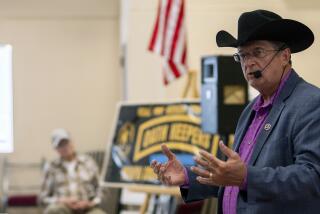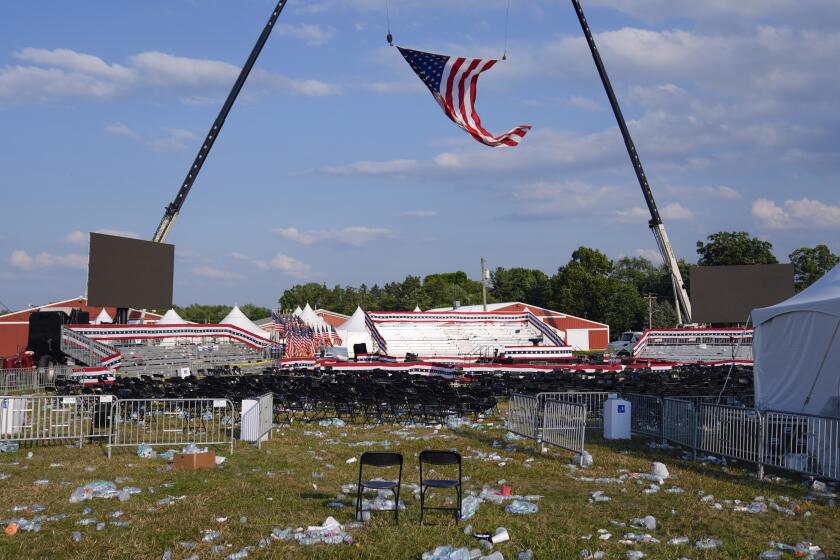U.S. focuses on Afghanistan
Amid rising anger over civilian deaths in Afghanistan, President Bush says he is sending more forces to fight there, but cautions “there will be times” when U.S. strikes result in the loss of innocent life.
In remarks prepared for delivery today to an audience of military officers, Bush is accepting recommendations from senior officers for a modest troop reduction in Iraq as part of a plan that would shift some units to Afghanistan.
The new configuration reflects what Bush is calling a “degree of durability” in progress in Iraq. But it also points to setbacks in Afghanistan and to criticism that Bush has focused too closely on Iraq at the expense of the Afghanistan effort.
Tension over civilian casualties in Afghanistan flared after an Aug. 22 U.S. strike in the western province of Herat in which Afghan and United Nations officials said 90 civilians died. U.S. military officials had concluded that 35 militants and up to seven civilians were killed.
However, the military is sending a senior officer to review new evidence after videos surfaced showing dead children and grieving Afghans. Two cellphone videos, obtained by the Associated Press, are said to show dozens of covered bodies, with injuries clearly visible.
Bush is addressing the issue in the face of growing criticism, including from Afghan President Hamid Karzai, a close ally.
“Regrettably, there will be times when our pursuit of the enemy will result in accidental civilian deaths,” Bush says in his prepared speech, without mentioning the Aug. 22 strike. “This has been the case throughout the history of warfare, yet our nation mourns every innocent life lost.”
The president says he has promised Karzai that “America will work closely with the Afghan government to ensure the security of the Afghan people while protecting innocent life.”
U.S. military officials emphasized they are not backing away from their earlier assessment, but acknowledged the new evidence was prompting a closer look.
“There are too many questions out there,” said a Defense official, speaking on condition of anonymity when describing internal decision-making. “So we need a review to validate our original findings.”
Bush will speak at the National Defense University in Washington. His remarks were released by the White House.
The shift in troop levels was widely anticipated and was the thrust of a recommendation by Army Gen. David H. Petraeus, the top U.S. military officer in Iraq who is about to become head of the U.S. Central Command, responsible for U.S. forces across the Middle East.
Citing a drop in civilian deaths and sectarian killings in Iraq and a return to “normal life,” Bush is offering an upbeat assessment.
“Here is the bottom line: While the enemy in Iraq is still dangerous, we have seized the offensive, and Iraqi forces are becoming increasingly capable of leading and winning the fight,” he says.
Under the plan Bush is endorsing, 3,400 support troops will pull out of Iraq over the next several months; a Marine battalion will be withdrawn in November, and an Army combat brigade -- 3,500 to 4,000 soldiers -- will leave in February.
All told, the United States will withdraw about 8,000 of the 140,000 troops now in Iraq, Bush says.
“If the progress in Iraq continues to hold, Gen. Petraeus and our military leaders believe additional reductions will be possible in the first half of 2009,” Bush says. But in Afghanistan, “huge challenges” remain.
He says “the Taliban and the terrorists” have been able to shake Afghan confidence. Democratic institutions are fragile, and the country has few natural resources.
As a result, Bush will say, a Marine battalion that was scheduled for deployment to Iraq in November will go to Afghanistan; in January, an Army combat brigade will follow.
--
Times staff writer Julian E. Barnes contributed to this report.
More to Read
Sign up for Essential California
The most important California stories and recommendations in your inbox every morning.
You may occasionally receive promotional content from the Los Angeles Times.










